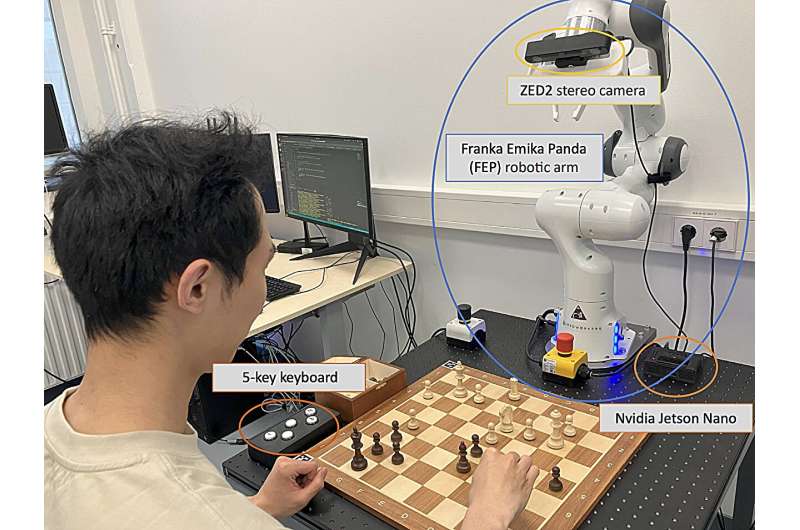June 14, 2024 feature
This article has been reviewed according to Science X's editorial process and policies. Editors have highlighted the following attributes while ensuring the content's credibility:
fact-checked
preprint
trusted source
proofread
An open-source robotic system that can play chess with humans

Artificial intelligence (AI) systems that can play games with humans have become increasingly advanced and have already been deployed by countless videogame developers worldwide. Most of these systems, however, are designed to compete against humans online, on digital platforms and in virtual environments, as opposed to physically in the real-world.
Researchers at Delft University of Technology (TU Delft) recently introduced a new open-source robotic system that can play chess against a human user in a real-world environment. This robot, outlined in a paper pre-published on arXiv, could prove to be a valuable resource for human-robot interaction research.
"Recent advancements in AI have sped up the evolution of versatile robot designs," Renchi Zhang, Joost de Winter, and their colleagues wrote in their paper. "Chess provides a standardized environment that allows for the evaluation of the influence of robot behaviors on human behavior. This article presents an open-source chess robot for human–robot interaction (HRI) research, specifically focusing on verbal and non-verbal interactions."
The robotic platform developed by the researchers includes both hardware and software components. The robot's hardware includes a Franka Emika Panda robotic arm with 7 degrees of freedom, a Franka robotic hand, a customized 3D-printed robotic gripper, a ZED2 StereoLabs camera, a keyboard, an external microphone and speaker connected to a computer, an NVIDIA Jetson Nano computer and a PC.
The robot also has several underlying software components, including a perception, an analysis and evaluation, a motion planning and execution and an interaction module. The perception module analyzes images of the chess board captured by the ZED2 camera and translates them into text descriptions.
Subsequently, the analysis and evaluation module feeds this text descriptions to a chess engine, to derive predicted moves and their corresponding scores. The motion planning and execution module then uses a predicted move to plan and execute the robot's chess moves.
Finally, the interaction module allows the robot to communicate with the human players they are competing against. To generate responses to a user's questions, this module relies on the API of OpenAI's conversational platform ChatGPT.
"OpenChessRobot recognizes chess pieces using computer vision, executes moves, and interacts with the human player using voice and robotic gestures," the researchers wrote in their paper. "We detail the software design, provide quantitative evaluations of the robot's efficacy and offer a guide for its reproducibility."
Zhang, de Winter and their colleagues evaluated their robotic platform in a series of initial tests, assessing its ability to compete against humans at chess. While they have not yet explored the perception of users who interacted with the robot, they found that the robot could effectively plan its future chess moves and move pieces to the desired locations on the board.
The robot's underlying code and the datasets used to train its classifiers are open-source and can be accessed on GitHub. The robot could thus soon be fabricated at other institutes to carry out further studies focusing on human-robot interaction.
"In the future, we intend to leverage this setup to study how AI-embodied robots influence people during interactions," Zhang, de Winter and their colleagues wrote. "This will involve the robot communicating with humans through emotional expressions and more natural verbal interactions. Extending the OpenChessRobot's capabilities beyond the chess application to general physical assistance is also an intriguing avenue to explore."
More information: Renchi Zhang et al, An Open-Source Reproducible Chess Robot for Human-Robot Interaction Research, arXiv (2024). DOI: 10.48550/arxiv.2405.18170
© 2024 Science X Network


















